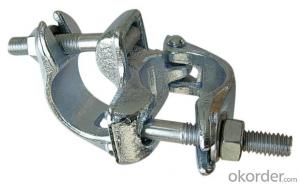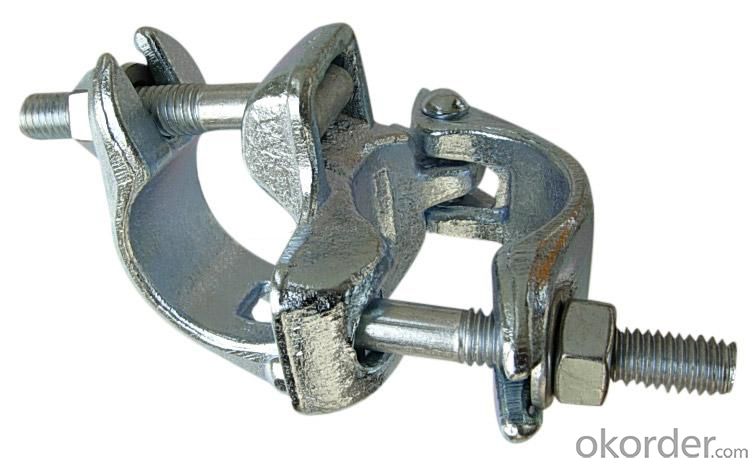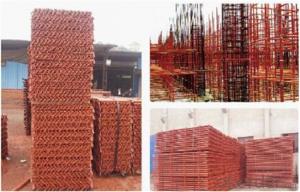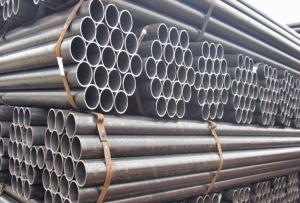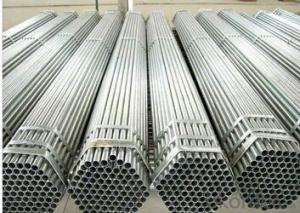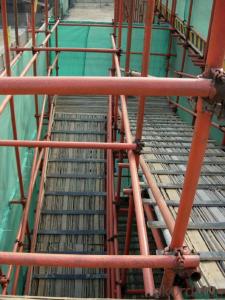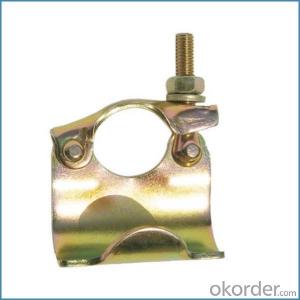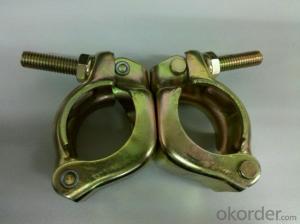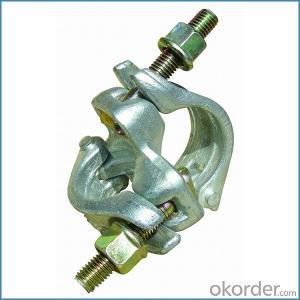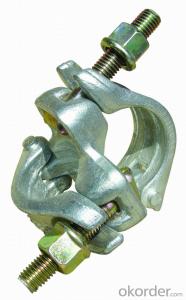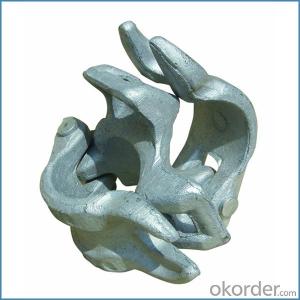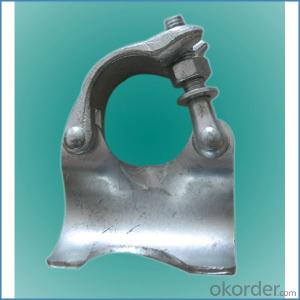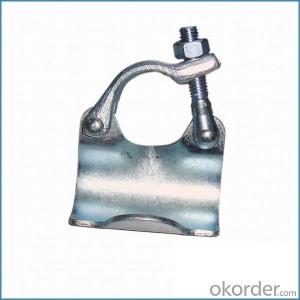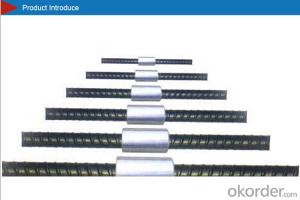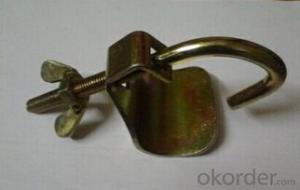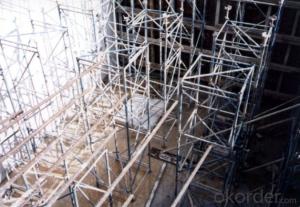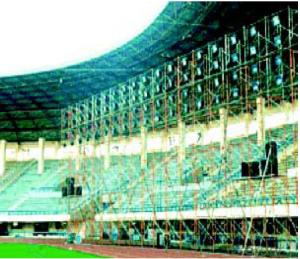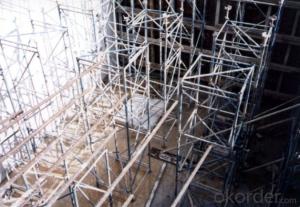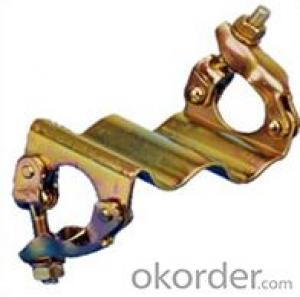Steel Scaffold Clamp Britis German Forged Type
- Loading Port:
- Tianjin
- Payment Terms:
- TT OR LC
- Min Order Qty:
- 1000 kg
- Supply Capability:
- 100000 kg/month
OKorder Service Pledge
OKorder Financial Service
You Might Also Like
Steel Scaffold Clamp Britis German Forged Type
Description
1.The scaffolding coupler is always used to connect the steel pipe as scaffolding system.
2.The often used coupler is swivel coupler and righ angle coupler .
3.We can provide types of scaffolding coupler according to your requirement.
4.Couoler can fix the 48.3mm scaffolding steel pipe tightly and make the whole scaffolding system more steadily.
Feature
(1)Excellent Anti-Breaking—Cold Pressed Steel
(2)Outstanding Resistance Deformation
(3)Strong Anti-Dropping Ability
Photo
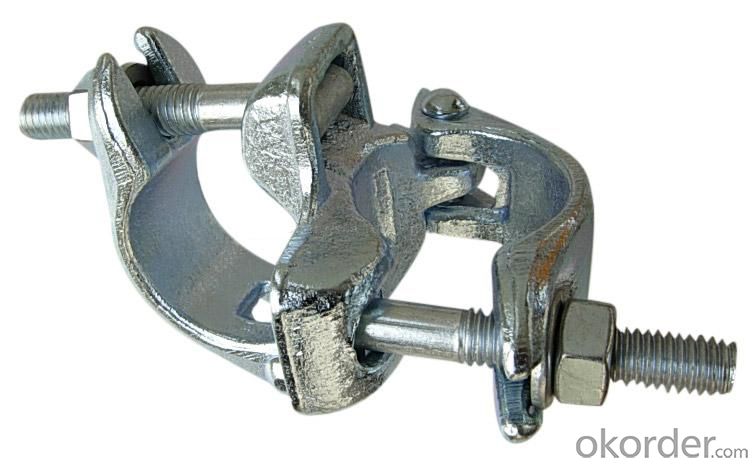
Parameter
| Material | Q235,345steel |
| Size | 48.3mm*48.3mm |
| Surface finish | Galvanized |
| Weight | 1.1kg around |
| Standard | BS1139,EN74 |
| Package | 25pcs/bag,steel pallet |
| Manufacture | As per customer requirement |
| Market | Africa, South America, the Middle East and Asia |
FAQ
Q: Are you a factory or trading company?
We are a state-owned corporation in China,dealing with various kinds of building materials.We have our holding subsidiaries.
Q: Where is your factory located? How can I visit there?
Our factory is located all around China.
Q: Can I get some samples?
Sample is free, customer only pay freight for the first time.
Q: Delivery?
10-30days. (5-15 containers)
Any question,feel free to contact us.
- Q: Are steel tube couplers suitable for scaffolding projects with specific load distribution needs?
- Scaffolding projects with specific load distribution needs can benefit from the use of steel tube couplers. These couplers are designed to securely connect scaffolding tubes, guaranteeing stability and strength. They are commonly employed in construction and industrial projects where safety and load distribution are paramount. Steel tube couplers excel at handling heavy loads and are engineered to evenly distribute weight, preventing concentration on a single point. This safeguards the structural integrity of the scaffolding and mitigates the risk of failures or collapses. What's more, steel tube couplers come in various types and sizes, enabling design flexibility and customization. This makes it possible to construct scaffolding structures that meet specific load distribution requirements. Additionally, steel tube couplers facilitate quick and easy assembly and disassembly. This proves particularly advantageous in time-sensitive projects or situations requiring frequent movement of the scaffolding. The ease of installation also allows for adjustments during the construction process, ensuring effective fulfillment of load distribution needs. In conclusion, steel tube couplers are a dependable and appropriate choice for scaffolding projects with specific load distribution requirements. They provide the necessary strength, stability, and flexibility while prioritizing worker safety and structure integrity.
- Q: Are steel tube couplers compatible with scaffolding systems that require specialized access solutions, such as ladder gates or trapdoors?
- Steel tube couplers are indeed compatible with scaffolding systems that necessitate specialized access solutions like ladder gates or trapdoors. These couplers are widely utilized in scaffolding systems due to their ability to establish a sturdy and trustworthy connection between the tubes, thus guaranteeing the structure's stability and safety. The integration of these couplers into scaffolding systems incorporating ladder gates or trapdoors is a seamless process, enabling convenient and secure access to various levels of the scaffolding. By ensuring the compatibility of steel tube couplers with specialized access solutions, workers can effortlessly maneuver the scaffolding, thereby increasing their productivity and safety when working at elevated heights.
- Q: Are steel tube couplers compatible with different types of scaffolding stairs or ladders?
- Yes, steel tube couplers are compatible with different types of scaffolding stairs or ladders. Steel tube couplers are commonly used in the construction industry to connect various components of scaffolding systems, including stairs and ladders. They provide a secure and reliable connection between the different parts, ensuring the stability and safety of the structure. Whether you are using steel, aluminum, or other types of scaffolding stairs or ladders, steel tube couplers can be easily integrated and used to connect these components together. Their versatility and compatibility make them a popular choice for scaffolding systems of different types and configurations.
- Q: Can steel tube couplers be used in scaffolding structures with specialized requirements, such as access for disabled individuals?
- Steel tube couplers can indeed be used in scaffolding structures with specialized requirements, including those that need to provide access for disabled individuals. Steel tube couplers are versatile and can be used to create various configurations and designs of scaffolding, making it possible to create structures that are specifically tailored to meet the needs of different individuals, including those with disabilities. For scaffolding structures that require access for disabled individuals, additional components such as ramps, handrails, and platforms can be easily incorporated into the design using steel tube couplers. These couplers allow for the secure connection of different scaffold tubes, enabling the construction of safe and sturdy structures that can accommodate wheelchair users or individuals with limited mobility. Furthermore, steel tube couplers offer the advantage of being adjustable and flexible, allowing for the scaffolding structure to be easily modified or expanded as needed. This versatility makes it possible to adapt the structure to different applications and requirements, including those related to accessibility. However, it is important to consider that while steel tube couplers can be used to create scaffolding structures with specialized requirements, proper planning, design, and installation are crucial to ensure compliance with safety regulations and standards. It is recommended to consult with scaffold engineering professionals or experts in accessibility to ensure that the scaffolding structure meets all necessary requirements and provides safe and accessible access for disabled individuals.
- Q: Can steel tube couplers be used in scaffolding structures with specialized requirements, such as protection against electromagnetic interference?
- No, steel tube couplers cannot be used in scaffolding structures with specialized requirements for protection against electromagnetic interference. Steel is a conductor of electricity and can easily conduct electromagnetic waves. Therefore, it would not provide any protection against electromagnetic interference. In such cases, alternative materials that are non-conductive to electricity, such as fiberglass or plastic, should be considered for the couplers to ensure the desired protection against electromagnetic interference.
- Q: What is the difference between a fixed coupler and a swivel coupler?
- A fixed coupler is a type of coupler that is rigid and does not allow any movement or rotation. It is designed to connect two pipes or tubes in a fixed position. On the other hand, a swivel coupler is a type of coupler that allows for movement and rotation of the connected pipes or tubes. It has a swivel mechanism that enables adjustments and flexibility in various angles.
- Q: What are the common challenges in using steel tube couplers in scaffolding?
- When using steel tube couplers in scaffolding, there are several challenges that may arise. Firstly, ensuring proper installation and alignment of the couplers can be a challenge. It is important to securely attach the couplers to the tubes and align them correctly to ensure stability and safety. This requires careful attention to detail and expertise in scaffolding assembly. Secondly, rust and corrosion can pose a significant challenge when using steel tube couplers. Steel is prone to rust, and if the couplers are not adequately coated or maintained, they can deteriorate over time. This can compromise the integrity of the scaffolding structure and create a safety risk. Regular inspection and maintenance, along with the use of corrosion-resistant coatings, can help address this challenge. Another challenge is the weight and size of the couplers. Steel tube couplers tend to be heavy and bulky, which can make them difficult to handle and transport. As a result, the time and effort required for scaffolding assembly and disassembly can increase. Additionally, the weight of the couplers can strain the scaffolding structure, necessitating careful consideration of load capacities and weight distribution. Furthermore, compatibility with different tube sizes can be a challenging aspect. Steel tube couplers are available in various sizes to accommodate different tube diameters, but ensuring the correct fit can be a challenge. It is crucial to select couplers that are compatible with the specific tubes being used and to follow manufacturer guidelines for installation. Lastly, cost can also present a challenge when using steel tube couplers. Steel is generally more expensive compared to alternative materials used in scaffolding, such as aluminum or plastic. This can result in higher overall project costs, especially for larger scaffolding structures. In conclusion, while steel tube couplers are widely utilized in scaffolding due to their strength and durability, they bring their own set of challenges. Proper installation, maintenance, rust prevention, handling, compatibility, and cost considerations are essential in ensuring safe and efficient scaffolding operations.
- Q: How do you ensure proper alignment and stability when using steel tube couplers in scaffolding?
- To ensure proper alignment and stability when using steel tube couplers in scaffolding, there are several key steps that should be followed: 1. Quality inspection: Before using steel tube couplers, it is crucial to inspect them for any signs of damage or defects. Look for cracks, deformations, or corrosion that could compromise their strength and stability. Only use couplers that are in good working condition. 2. Proper selection: Choose the appropriate type and size of steel tube couplers for the specific scaffolding application. Consider factors such as the load requirements, tube diameter, and scaffold design. Using the wrong couplers can lead to misalignment and instability. 3. Tightening: When connecting the tubes with couplers, ensure that they are tightened securely using the appropriate tools, such as scaffold spanners or ratchets. Tighten the couplers to the recommended torque value specified by the manufacturer. Loose or improperly tightened couplers can cause misalignment and compromise the stability of the scaffolding. 4. Alignment checks: Regularly inspect the alignment of the tubes and couplers to ensure they are properly aligned. Misalignment can occur due to settling, vibrations, or improper usage. Use a straight edge or laser level to check the alignment, and if any misalignment is detected, make the necessary adjustments and re-tighten the couplers. 5. Stability measures: In addition to proper alignment, stability is crucial for safe scaffolding. Ensure that the base of the scaffolding is stable and level, and that it is properly anchored or tied to the structure if required. Use diagonal braces to enhance stability and prevent lateral movement. Regularly inspect the stability of the scaffolding during use and make any necessary adjustments or reinforcements to ensure its stability. 6. Compliance with regulations: Always follow the local and national regulations and guidelines for scaffolding installation and usage. These regulations often include specific requirements for the type and use of steel tube couplers. Adhering to these regulations helps ensure proper alignment and stability, as well as the overall safety of the scaffolding system. By following these steps, proper alignment and stability can be achieved when using steel tube couplers in scaffolding, reducing the risk of accidents and ensuring a safe working environment for those using the scaffolding.
- Q: Can steel tube couplers be used in scaffolding projects with limited access to power sources?
- Indeed, scaffolding projects with restricted access to power sources can incorporate steel tube couplers. These mechanical fittings enable the connection of steel tubes, forming a sturdy scaffold structure. Their usage does not necessitate any power source, as they rely on the manual tightening of bolts or clamps to secure the tubes firmly. This aspect renders them highly versatile and convenient for scaffolding ventures in remote or off-grid areas, where power sources may be scarce or nonexistent. Furthermore, steel tube couplers are renowned for their robustness and longevity, rendering them appropriate for a wide range of construction or maintenance projects.
- Q: What are the load capacities of different types of steel tube couplers?
- The load capacities of different types of steel tube couplers can vary depending on their design, size, and material composition. However, it is important to note that load capacities are typically provided by the manufacturer and can be specific to each individual product. In general, steel tube couplers are designed to provide a secure and reliable connection between steel tubes in various applications such as scaffolding, construction, and engineering projects. These couplers are often used to join tubes together to create a stable and load-bearing structure. Load capacities for steel tube couplers can be determined through rigorous testing and analysis by the manufacturer. The capacity is usually expressed in terms of the maximum load that the coupler can safely withstand without failure or deformation. This load capacity is often specified in terms of either a maximum allowable load or a maximum allowable torque. The specific load capacities of steel tube couplers can vary depending on factors such as the type of coupler, its size, and the material from which it is made. For instance, couplers made from higher-grade steel alloys may have higher load capacities compared to those made from lower-grade materials. To determine the load capacity of a specific steel tube coupler, it is recommended to refer to the manufacturer's specifications or consult with a structural engineer or technical expert. These experts can provide accurate and reliable information on load capacities based on the specific requirements and conditions of the project or application.
Send your message to us
Steel Scaffold Clamp Britis German Forged Type
- Loading Port:
- Tianjin
- Payment Terms:
- TT OR LC
- Min Order Qty:
- 1000 kg
- Supply Capability:
- 100000 kg/month
OKorder Service Pledge
OKorder Financial Service
Similar products
Hot products
Hot Searches
Related keywords
